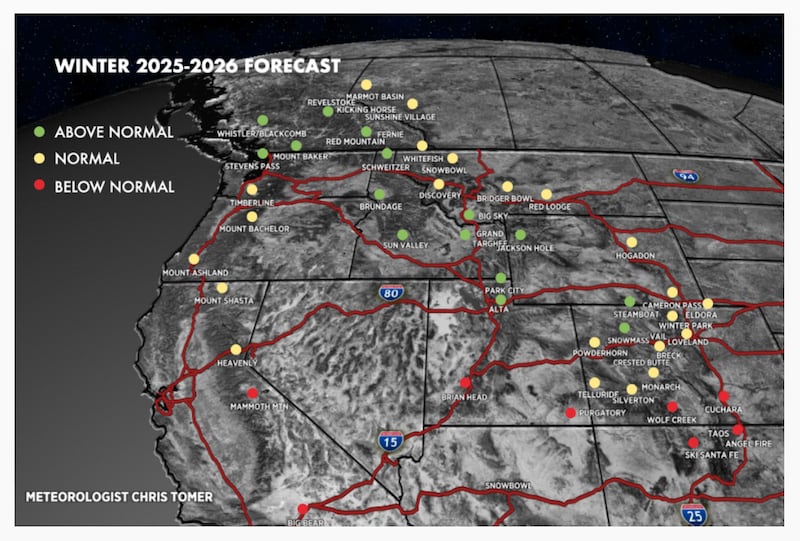- A long-range forecast predicts above-average snowfall at northern Utah ski areas.
- Resorts in southern Utah and southern Colorado could be drier than normal.
- La Niña could bring more snow to the Pacific Northwest, Montana, Idaho and Wyoming.
With warm temperatures of late, nobody’s thinking about snow. But the days are getting shorter and the nights cooler. And that means the winter ski and snowboard season isn’t far behind.
So, what’s in store for Utah mountain resorts and others in the West this year?
OnTheSnow meteorologist Chris Toomer has some thoughts in his long-range forecast for North America.
The National Oceanic and Atmospheric Administration has issued a La Niña watch, anticipating it to occur in October and continue through the end of the year, fading early in 2026.
“La Niña tends to organize the wintertime jet stream in a way that favors the Pacific Northwest and northern tier of states with the most consistent winter snowfall,” according to Toomer. “La Niña tends to leave California and the southern tier of states drier and warmer than normal.”
And that’s what he sees happening this winter.
Looking north
“At times, this winter may very well look a lot and feel like last winter but not the entire time,” he said in an online video detailing his forecast. Last year, La Niña hung around for most of the ski season, ending around April the same time as the season came to a close.
“Overall, the winter is going to favor the northern tier of states — the Pacific Northwest, B.C., parts of Montana, parts of Idaho, parts of Wyoming, parts of northern Utah, parts of northwest Colorado," Toomer said.
Those areas, he said, will see the most consistent precipitation whether it be rain or snow.
“That covers a lot of major ski areas. There’s a lot of big mountains across the West,” he said.
But he predicted southern Utah, southern Colorado and New Mexico to be drier than normal.

What Utah resorts will get the most snow?
“My storm track also favors some of Utah, but only the very northern part in the Wasatch range. I believe it’ll be a sharp cutoff south of that,” Toomer said.
He said he debated whether to include the Wasatch mountains among the areas he anticipates will have more snow than normal.
“But I said, ‘You know what, let’s just include the entire Wasatch.’ I think it’s very possible that if we get enough of these northwest flows, that’d be a big deal and that’ll keep the wintertime precipitation to at least normal, if not slightly above normal,” he said.
Toomer predicts Snowbasin, Powder Mountain, Park City, Deer Valley, Brighton, Solitude, Alta and Snowbird will see the most consistent snow among northern Utah resorts.
But he sees another down year for Brian Head in southern Utah. Despite low snow accumulation last year, the resort had its longest season on record, aided by some late-season storms.
In Colorado, he forecasts above-normal snowfall at Steamboat, and possibly Vail and Aspen Snowmass. He also includes Jackson Hole and Grand Targhee in Wyoming, Sun Valley in Idaho and Big Sky in Montana among that group.
Toomer cautioned against reading too much into early predictions.
“Keep in mind that this is a forecast, and a long-range forecast at that,” he said. “What’s forecasted in the fall for the upcoming winter often varies, and can vary significantly, from what actually happens.”
For example, Toomer noted that a rare triple-dip La Niña in the 2022-23 season brought record snowfall to a number of resorts in Utah and California. La Niña gave way to El Niño the next year but returned last season.

